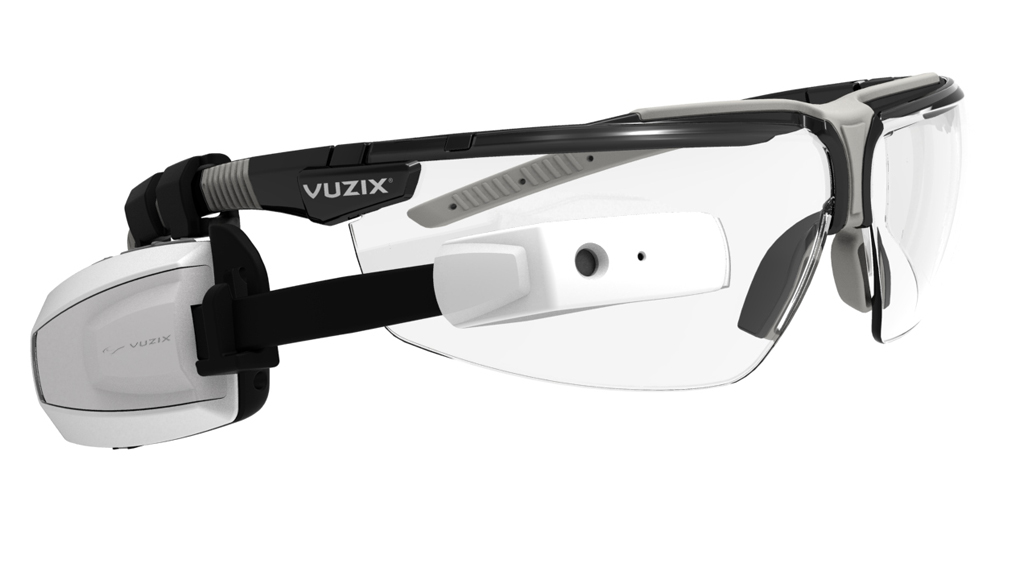The Past, Present, And Future Of VR And AR: The Pioneers Speak
Vuzix Corporation M100
The Vuzix M100 are wearable monocular glasses (works with either eye) with a WQVGA color display (the company literature says the image is the equivalent of a 4-inch smartphone screen held at about a 14-inch distance), 15 degree field of view, running Android ICS on a TI OMAP4460 processor at 1.2 GHz, with 1 GB of RAM, 4 GB of flash, and a micro SD slot for up to 32 GB of storage. The unit contains sensors for gestures, ambient light, GPS, and proximity. Its head tracking includes three degrees of freedom, has a three-axis gyro, accelerometer, and compass. The camera shoots five-megapixel still shots and 1080p video. Audio goes to a single ear, and dual mics let you record audio and provide voice input with noise cancellation. It comes in gray or white and costs $1000.
Dan Cui, Vuzix vice president of business development answered Tom's Hardware's questions.
| Vuzix M100 Specs | |
|---|---|
| Resolution | WQVGA Color display |
| Aspect Ratio | 16:9 |
| Field of View (Diagonal) | 15 degrees, equivalent to 4 in. mobile device screen seen at 14 in |
| Brightness | >2000 nits |
| Color | 24-bit |
| Eye | Left or right eye usable |
| SoC | OMAP4460 at 1.2 GHz |
| RAM | 1 GB RAM |
| OS | Android ICS 4.04, API 15 |
| Storage | 4 GB flashExternal Flash SlotMicro SD support up to 32 GB |
| Controls | 4 control buttonsRemote control app, runs on paired Android deviceSupports customizable voice navigationSupports gesturing |
| Sensor Systems | 3 DOF gesture engine (L/R,U/D,N/F)Ambient lightGPSProximity |
| Integrated Head Tracker | 3-degree of freedom head tracking3 axis gyro3 axis accelerometer3 axis mag/integrated compass |
| Integrated Battery | 550 mAh rechargeable internal batteryUp to 6 hours hands free (display off)2 hours hands free + display1 hour hands free + display + camera + high CPU loading |
| External Battery | 3800 mAh rechargeable batteryUltra-thin USB mini-B cablePowers & recharges M100115 x 58.6 x 10 mmIncreases run time up to 6.5 times over base M100 |
| Hands Free | Ear speakerNoise cancelling microphone |
| Camera | 5 megapixel stills1080p video16:9 aspect ratio |
| Mounting Options | Over headSafety glasses (included)Use with left or right eye |
| Connectivity | Micro USB: control/power/upgradeWi-Fi 802.11b/g/nBluetooth |
| Supported Host Devices Software | AndroidiOS (in development) |
Tom's Hardware: Is your technology based on AR or VR, and why?
Vuzix: The M100 can do both. Since it is a digitally see-through display, you have the ability to show a completely computer generated image (VR) or superimpose computer data over the real world (AR).
Tom's Hardware: When will we see mass adoption of VR and AR technology (defined as more than one million customers)?
Vuzix: Soon. Analysts say that millions of smart glasses will be sold this year, growing to tens of millions by 2016. The majority of smart glass users in 2014 will be out of the enterprise, industrial and medical sectors, not consumer.
Tom's Hardware: What are the technical hurdles still standing in the way?
Vuzix: Batteries are still a big issue. AR, VR, and streaming video communications require horsepower, which means larger batteries. So there’s a balancing act between batteries embedded in a wearable headset and form and fit of the industrial design.
Get Tom's Hardware's best news and in-depth reviews, straight to your inbox.
Optics are another hurdle. Most of today’s products like Google Glass, Oculus Rift, and others use large prism-based “light pipes” to deliver the image to the eye. These system create large industrial designs that make them unusable in most industrial instances, and certainly out of the question for the average consumer.
Tom's Hardware: What are the non-technical hurdles standing in the way?
Vuzix: Individual preferences. Wearable tech needs to address a fundamental human instinct: vanity. Those of us in technology need to understand that and work towards integrating technology with industrial designs that are acceptable to those who wear it.
Tom's Hardware: What steps are needed to remove those hurdles?
Vuzix: On the technology side, while processors are getting smaller, more powerful, and less power hungry, battery technology still has a long way to go. The speed of advancements in processors technology far exceeds that of battery technology. We may end up getting to a point where processors become so small that the majority of the industrial design can be taken up by the batteries that power them. We’re still a long way from that point, so for the foreseeable future, you either have to recharge during the day (for heavy users) or use an external battery to keep you operational all day long. With regards to Optics, we need to develop new see-through technology that has a form factor similar to normal sunglass lenses.
Tom's Hardware: What is your company doing specifically and technically to remove those hurdles?
Vuzix: Battery and processor technology is out of our hands. We can only work closely with the technology companies who design and manufacture those devices to ensure that our needs in the wearable market are addressed.
For Optics, Vuzix has invested millions into the development of a new see-through lens technology. We call this “waveguide” optics. Essentially it allows us to use a 1.4 mm-thin lens as the display, doing away with the expense and bulkiness of conventional prism based systems. Additionally, the work done by Vuzix produces a clear, see-through lens without any distortions in front of the eye, unlike some competing technologies that use “venetian blind” type of reflective elements. These elements slightly distort the image and can also produce eye strain in users.
The Vuzix waveguide optic will also make see-through binocular smart glasses possible (think regular sun glasses). Binocular devices are better suited for AR use and are more likely to be accepted by average consumers over a monocular (one eye) device.
Tom's Hardware: How will VR and AR change the gaming ecosystems in the future (PCs and components, consoles, controllers, and the games themselves)?
Vuzix: Vuzix primarily markets its smart glasses to the industrial sector. As Google is finding out, there is no overriding “killer app” that drives consumers to purchase smart glasses. That is why they are shifting gears and quietly going after the industrial markets. AR has been around for a long time. There are no barriers to entry into this space and you will see a growing number of Oculus Rift type of products appear in the very near future, driving the price of these products lower and lower. That’s great news for the consumer but certainly bad for the companies entering into the space.
AR is a different beast. The game world can be merged with “reality” which is a significant paradigm shift from the virtual world. Game developers have exciting new levels of freedom on how they architect the game stage. Gaming is no longer restricted to a stationary location; it can become mobile, offering many more choices for real time interaction with other players or passive elements (people or things).
Tom's Hardware: How will VR and AR change the world outside of gaming? Give us the most remarkable, life-changing examples you expect to see.
Vuzix: Where can your imagination take you? Imagine walking into a Walmart and having a sales associate be able to answer your questions, tell you where to find the product you’re looking for, how many are in stock and process your order before you get to the front door. How about going to have your blood drawn for a medical test where the lab tech puts on glasses that allows him/her to see exactly where your veins are so they only stick you once with the needle to get the blood?
Smart glasses that enhance your night vision while providing directions as well. Or sports enthusiasts who can see exactly how they’re performing in real time. Plan a new garden layout, put on your glasses, and go outside and plant your flowers according to the plan you outlined with each plant location identified before your eyes. Detect medical conditions on your family just by looking at them: pulse, temperature, respiratory rate, eye dilation, all of which can immediately be forwarded to the doctor. Security at transportation centers and other critical areas; body feature recognition, etc.
The list is unlimited. While many of the applications that drive smart glasses can also be run on smart phones/tablets, walking around holding your phone or table in the air in front of you is not only awkward, but unsafe. Smart Glasses provide a powerful way of viewing AR data in a safe, hands-free manner without drawing undue attention to yourself.
-
icepick314 would Virtual Boy from Nintendo count as VR tech?Reply
it's missing in the article's timeline...
also an arcade game Time Traveler that had "holographic" screen... -
Cazalan I think they're wasting too much time on the motion capturing aspect. Just give me a headset that looks better than a 30" monitor and I'm sold.Reply -
Vlad Rose With the Virtual Boy, I would call it VR tech as it uses similar technology that used in the VR gear that is coming out. With Time Traveler and Holosseum, I would say no. What they used was a single 2D screen that was projected to a curved mirror to create a false reality of the image 'sticking out'. It is more comparable to 3D movies than Virtual Reality.Reply -
clonazepam The Vuzix seems pretty cool. We've already accepted bluetooth headsets and its a very similar look. I hope they all account for the fact that some people are right-handed and left-eye dominant or other way around, as well as color blind or red / green deficient.Reply
I think the Vuxio would be the most useful in everyday life, while obviously Oculus or Morpheus being the most fun. -
Shankovich Morpheus looks cool but it just can't compete with the rift when hooked up to the PS4; it just doesn't have the graphical power to run above 1080P games with acceptable level of detail, effects, etc. especially when the frame rate will need to be at 60fps or more to reduce nauseating effects. On PC, the rift has better sensors (geomagnetic) and is better able to take care of movement lag.Reply -
CaedenV @CazalanReply
Agreed. I am all for VR to hit when it is really ready, but until then I would be extremely happy with a high resolution headset to use as an immersive display. I don't want to have to crane my neck and change my body's orientation when gaming. I still want a keyboard/mouse or controller as input and be able to sit back on the couch and just play a game. I have a nice big yard to work on if I want something active to do... when I am gaming I want to get into it, but with the least amount of physical effort possible. -
Henderburn The VR timeline should include the release of "Snow Crash," the novel that inspired John Carmack and Michael Abrash to make Quake and build the foundations for VRReply -
WyomingKnott I'm still waiting for a decent eyeglass-size display so I can read a book while the dentist pokes at my teeth. Seriously, we don't have even the basic display element available commercially?Reply -
Cybolic Vuzix examples are probably the worst I've ever heard: "having a sales associate be able to answer your questions" and "see exactly where your veins are so they only stick you once with the needle to get the blood", yeah, they are supposed to already be able to do that without wearing special glasses; it's literally what they're being paid for.Reply


